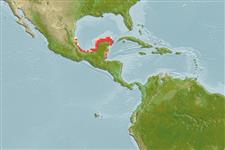Cephalopoda |
Octopoda |
Octopodidae | Octopodinae
Environment: milieu / climate zone / depth range / distribution range
Ecology
Benthic; depth range 0 - 100 m (Ref. 83938). Tropical; 23°N - 16°N, 98°W - 86°W (Ref. 96968)
Western Central Atlantic: Endemic to Mexico.
Length at first maturity / Size / Weight / Age
Maturity: Lm 12.4 range ? - ? cm Max length : 12.0 cm ML male/unsexed; (Ref. 96968); max. published weight: 5.0 kg (Ref. 96968)
Total length is 130 cm (Ref. 96968). Minimum depth from Ref. 96968. It was also known to be caught by artificial lures and dipnets. In the 1980's catch was reported from 5000 to 8000 tonnes annually. Then in 2000, it was estimated around 9000 tonnes (Ref. 96968). This is a benthic and subtidal species found in rocky and seagrass bottoms (Ref. 83938). Also inhabits empty coral shells (Ref. 275) and coral reefs (Ref. 96968).
Life cycle and mating behavior
Maturity | Reproduction | Spawning | Eggs | Fecundity | Larvae
Members of the class Cephalopoda are gonochoric. Male and female adults usually die shortly after spawning and brooding, respectively. Mating behavior: Males perform various displays to attract potential females for copulation. During copulation, male grasp the female and inserts the hectocotylus into the female's mantle cavity where fertilization usually occurs. Life cycle: Embryos hatch into planktonic stage and live for some time before they grow larger and take up a benthic existence as adults.
Roper, C.F.E., M.J. Sweeney and C.E. Nauen. 1984. (Ref. 275)
IUCN Red List Status (Ref. 130435)
CITES status (Ref. 108899)
Not Evaluated
Not Evaluated
Threat to humans
Human uses
Fisheries: commercial
FAO - Fisheries: landings | FishSource | Sea Around Us
Tools
Internet sources
Estimates based on models
Preferred temperature
(Ref.
115969): 23.9 - 27.7, mean 26.5 (based on 80 cells).
Vulnerability
Very high vulnerability (78 of 100).
Nutrients: Calcium = 126 [75, 177] mg/100g; Iron = 4.79 [1.67, 7.92] mg/100g; Protein = 15.5 [13.7, 17.4] %; Omega3 = 0.414 [0.262, 0.566] g/100g; Selenium = 57.8 [48.5, 67.2] μg/100g; VitaminA = 0 μg/100g; Zinc = 1.97 [0.92, 3.02] mg/100g (wet weight).
